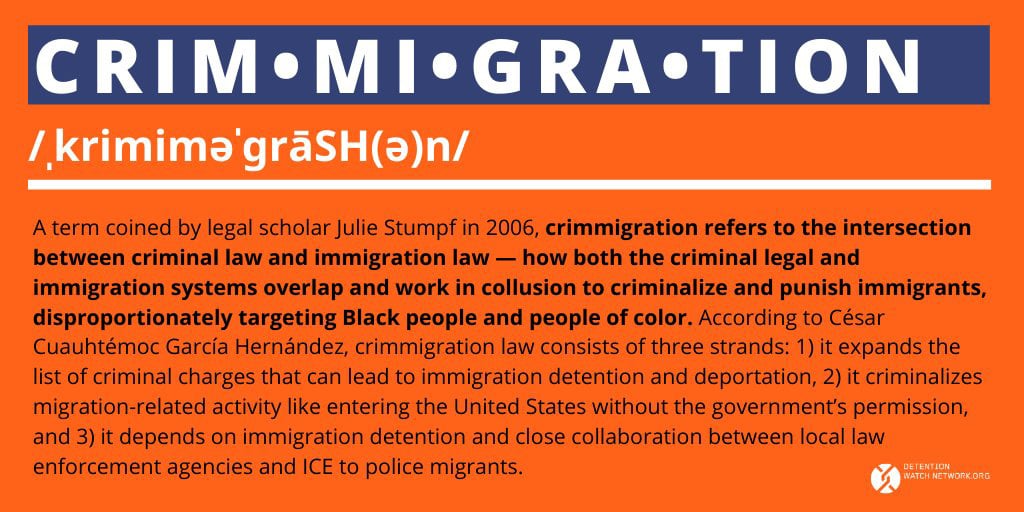Criminal law and immigration law have traditionally worked in distinctly different areas of the law. Non-citizens of the United States were subjected to federal laws that determined who was allowed into the country and who was not. When the government discovers that a migrant in the United States has broken immigration law, federal immigration officers begin the process of coercive removal known as expulsion from the country.
Alternatively, anyone accused of committing a crime is detained by police officers, processed through the criminal justice system, and, if convicted, punished. This is true for citizens of the United States as well as non-citizens of the United States. People were punished according to the laws made by legislators for most of the country’s history, but they were punished the same regardless of citizenship status.
Beginning in the mid-1980s, the sharp distinction between criminal law and immigration law began to blur. The line between these previously distinct areas of law began to dissolve two centuries into the United State’s existence. It’s difficult to tell where the criminal justice system ends and immigration procedure actually begins these days.
Immigration is the most common sort of offense prosecuted today in federal courts. Meanwhile, persons who may be deported from the United States are typically incarcerated behind steel doors and encircled by barbed wire. This is the law of Crimmigration.
Crimmigration Definition

Juliet Stumpf, a professor at Lewis & Clark University Law School, noted in the seminal essay that coined the phrase “Crimmigration” that the line between criminal and immigration law “has grown hazy” to the point that the two “are only nominally separate.” “Crimmigration Law” has grown since Stumpf’s article was published in 2006.
Crimmigration Law can now be thought of as having 3 basic characteristics:
- First, the federal government can now exclude or deport (legally referred to as “removal”) a migrant from the United States more easily than ever before.
- Second, the criminal justice system has grown increasingly focused on illegal immigration.
- Third, prosecutors and law enforcement agencies have adapted their enforcement strategies to increase the stakes of a person’s migratory status.
Immigration-related Consequences of Conviction legal proceedings in which expulsion or removal is decided are now treated as merely administrative hearings in which a federal government employee assesses whether a particular person merits authorization to enter or remain in the United States.
These hearings are recognized as legal proceedings in which removal is resolved. These hearings take place in the Justice Department’s immigration courts. Immigration judges who work for the attorney general, not the federal judiciary, preside over these hearings.
The United States Supreme Court has repeatedly held that forcible expulsion from the United States is not a form of punishment. Because of these findings regarding the legal nature of immigration law, there is no entitlement to appointed counsel in immigration court. Other characteristics of legal proceedings in the United States are also missing.
There is no right to confront witnesses, no immunity from self-incrimination, no presumption of innocence, and only limited power to dismiss evidence collected through illegal law enforcement operations.
Few persons were deported from the United States owing to criminal conduct until the latter decades of the twentieth century. Only 14,287 persons were deported from the United States due to criminal conduct in the 92 years between 1892 and 1984. 56,669 people were deported for the same cause during the same time period. During this time period, a total of 70,956 people encountered some form of immigration repercussion as a result of criminal activity.
By comparison, the Immigration and Customs Enforcement agency (ICE) reported removing 185,884 people were removed from the United States in 2020, a 26% decrease from 2019. To put it another way, in 2020 alone, more people were deported from the United States as a result of criminal action than in the entirety of the twentieth century.
See U.S. Immigration and Customs Enforcement Fiscal Year 2020 Enforcement and Removal Report:
https://www.ice.gov/doclib/news/library/reports/annual-report/eroReportFY2020.pdf
The One third-million persons (359,885 removals in 2019) who are deported each year is a staggering number. Of those deportations, the ones who are deported as a result of criminal conduct number typically a full quarter of a million people and are a diverse group. Some are legal permanent residents in the United States.
They are the most privileged form of migrant since they have the right to remain and work in the United States eternally as long as they follow all immigration laws. Others are those who have been granted permission to visit for a limited time, such as students engaged in an academic program. Others are here without permission from the federal government.

More importantly, the type of crime committed by these individuals differs greatly. To be sure, some people engage in the most atrocious of deeds. The majority deported due to commission of a crime do not.
For example, in 2013, 31% of the 216,810 people deported with a criminal record were convicted of nothing more serious than a federal immigration felony (typically entering the United States without the consent of the federal government, one of two often prosecuted federal offences). A further 16% had been convicted of drug offenses. While some of these entail big drug trafficking offenses, the majority of them involve ordinary drug possession in tiny amounts.
In effect, the vast majority included drug conduct that is currently legal in 26 states and the District of Columbia. Motor-vehicle traffic violations were the second most common type of infraction that landed people in immigration court in 2013. Traffic infractions, which accounted for 15% of all criminal removals, still surpassed assault crimes, which accounted for 10% of all removals.
Immigration Law Victims
The Criminal Justice System and Migrants Modern immigration law make the criminal courtroom the most crucial stage for determining whether a person will be allowed to remain in the United States by tying removal to criminal convictions.
Padilla v. Kentucky, a landmark 2010 ruling by the United States Supreme Court, recognized the changing environment of immigration law. “Recent modifications in our immigration laws have made deportation practically automatic for a large group of noncitizens.” As a result, we find it ‘very difficult to separate the penalty from the conviction in the context of deportation.”
The Padilla judgment by the Supreme Court ushered in a period of rapid change in the criminal justice system.
The United States Constitution’s Sixth Amendment guarantees that anyone charged with a criminal offense who is unable to afford an attorney would be given one at the government’s expense. The principle behind what has become a core aspect of the United States’ conception of justice is that no one should lose their liberty or life due to poverty.
“In our adversary system of criminal justice, any individual [hauled] into court, who is too poor to hire a lawyer, cannot be promised a fair trial unless counsel is supplied for him,” the Supreme Court stated in a previous landmark case on the right to counsel, Gideon v. Wainwright.
Criminal Defense Attorneys vs Immigration Law
Criminal defense attorneys play an outsized role in determining the destiny of their migrant clients, with a counsel at their side assured and modern immigration law’s emphasis on criminal conduct to determine removal. As a result, the Padilla Court determined that the Sixth Amendment required criminal defense counsel to inform their non-citizen clients with the immigration repercussions of their conviction.
This is true regardless of the type of criminal charge a person is facing or whether the criminal proceeding is under state or federal law. While some criminal defense attorneys are required to evaluate the immigration implications of a client’s situation, others find themselves defending migrants facing criminal accusations connected to immigration.
Those who commit immigration violations are the subject of the great majority of new criminal prosecutions brought in federal courts across the country. Federal courts, for example, completed 92,345 immigration crime prosecutions in 2012. Drug offenses were the second most commonly prosecuted type of crime that year, with fewer than 40,000 prosecutions. Both numbers had reduced four years later, but the trend had not changed.
In 2016, there were 68,314 immigration offenses prosecuted and less than 24,000 drug offenses prosecuted. Illegal entrance and reentry make up the majority of federal immigration offense prosecutions. The former penalizes those who enter the United States without permission from the federal government. The latter aims to do so after having been previously removed.
Despite the fact that both crimes have been on the books since 1929, neither was employed regularly until President George W. Bush’s second term. Under President Obama, federal prosecutors kept up the trend. The federal government isn’t the only one who has increased the penalties for migrants caught up in the criminal justice system. A number of states have also contributed. Arizona has been the most notable.
When Governor Jan Brewer signed Senate Bill 1070, sometimes known as the “show-me-your-papers” legislation, into law in 2010, Arizona’s efforts to strengthen the repercussions of immigration law infractions propelled it into international prominence. A protracted legal battle ensued, prompting the federal government to take the extraordinary step of filing a lawsuit against Arizona. The United States Supreme Court eventually weighed in, declaring that much of S.B. 1070 is unconstitutional.

The much-maligned portion of the Arizona law permitting police officers to examine the immigration status of anybody lawfully detained, stopped, or arrested was the only disputed component that remained in place. Though the statute is not inherently illegal, the Court warned that it could easily be applied in an unlawful manner if it was used as a justification to hold people simply to inquire about their immigration status or if it was applied discriminatorily.
Several states followed Arizona’s lead in a variety of ways, directing their criminal law enforcement capabilities straight into immigration law enforcement. Alabama, for example, established a state organization to coordinate immigration enforcement actions. The use of forged citizenship documents is illegal in California. In the last few months, legislators in more than a half-dozen states have sponsored bills to expand the role of local police in detaining people on behalf of federal agents.
The fourth component of the immigration law is the deployment of unusual or unusually harsh law enforcement techniques against migrants. It should come as no surprise that with so many people being prosecuted for immigration-related crimes, the number of migrants imprisoned is correspondingly large. Approximately half a million people are imprisoned each year as a result of an immigration law infraction. ICE alone detains about 400,000 migrants each year while they await word on whether or not they will be permitted to stay in the United States.
The United States Marshals Service, a subsidiary of the Justice Department, detains tens of thousands of persons who are awaiting prosecution for an immigration crime. The Marshals Service, which is in charge of detaining anyone facing federal criminal charges who cannot be released on bail, took 97,982 suspected immigration offense offenders into custody in 2019.Currently over 20,886 people are charged with a federal narcotics felony, the second most common reason for pretrial detention. Almost every defendant charged with an immigration crime will be found guilty. When this happens, they are sent to the Bureau of Prisons, which is part of the Justice Department. The BOP has been holding around 20,000 convicted immigration violators per day in recent years.
Migrants who are rushed through the criminal justice system are frequently devoid of procedural safeguards that are characteristic of ordinary criminal prosecutions. For example, the notion that every defendant is entitled to a day in court presupposes that the defendant will have the opportunity to get the undivided attention of the judge.
Indeed, before accepting a guilty plea, a judge must “address the defendant personally in open court,” according to Rule 11 of the Federal Rules of Criminal Procedure, a set of statutory instructions that govern federal criminal trials. For many migrants facing immigration crime accusations, that requirement has been severely undercut by a quick-adjudication mechanism called Operation Streamline.
Federal prosecutors collaborate with federal courts to expedite the processing of huge numbers of immigration offense cases under this effort. Dozens of defendants are presented to a federal judge simultaneously. Some reports indicate that as many as 100 immigration crime defendants will be brought before a federal judge at the same time.
Judges then review the criminal process with defendants, asking them a series of questions intended to gauge whether they understand what is happening. Though federal judges are required to engage in this colloquy with all defendants (state judges follow similar routines), it is unheard of outside of the context of federal immigration crimes for judges to regularly engage in en masse plea hearings.
Anyone who speaks to large audiences can guess the downside of en masse hearings. A speaker who presents a question to a room full of people is likely to receive some response. Understanding who said what and who said nothing, however, is next to impossible.
As the United States Court of Appeals for the Ninth Circuit explained when reviewing a legal challenge to Operation Streamline, all a judge is likely to hear is “an indistinct murmur or medley of yeses.”
This is poor practice in most public-speaking contexts. When it comes to criminal proceedings, however, the questions that a judge asks can form the foundation for a conviction and punishment. For that reason, to be labeled a federal convict requires more precision when it comes to all crimes except those related to immigration.
Crimmigration Law’s Future As deeply as crimmigration law has become embedded in contemporary law and law enforcement, it remains in its infancy. Only three decades into its evolution, it is difficult to know whether crimmigration law will remain a standard feature of the United States legal system. Without question, signs suggest that crimmigration law is likely to expand, not contract, in the immediate future.
During the Trump administration, top officials have repeatedly expressed a desire to focus the immigration court system’s focus on people with criminal histories, prosecute more federal immigration crimes, expand the federal government’s detention capacity, and enlarge federal cooperation with state and local governments interested in helping identify and apprehend suspected immigration law violators.
Needless to say, the impractical methods and potential unfairness to immigration violators due to the current detainment process are atrocious.
Imagine what happens to a non-English speaking immigration violator without an attorney?
If you or a loved one is currently detained on an immigration violation or a criminal charge that threatens immigration status you desperately need an experienced Crimmigration attorney to help you. Without representation, the results are almost guaranteed to be negative.
Call 214 Release: Hindieh Law, PLLC at 214-Release (214.960.1458) for a free confidential consultation today to get help to preserve your rights and avoid deportation.






